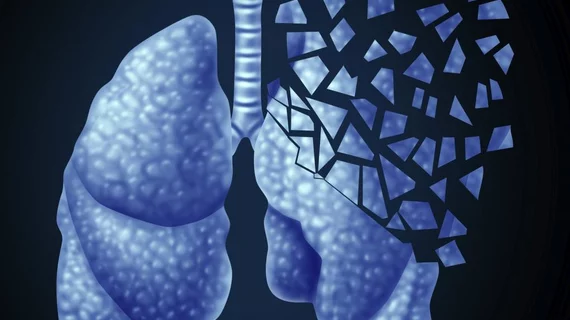What NLST data tells us about Lung-RADS classifications
Subsolid pulmonary nodules classified as Lung Imaging Reporting and Data System (Lung-RADS) categories 2 and 3 may have a higher risk of malignancy than previously believed, according to new findings published in Radiology.
The study’s authors examined more than 400 subsolid nodules from the National Lung Screening Trial (NLST), remeasuring each nodule and looking at any subsequent follow-up imaging results. Overall, 304 nodules were classified as Lung-RADS category 2. The malignancy rate for those nodules was 3%, higher than the 1% reported as part of Lung-RADS. In addition, 67 nodules were classified as Lung-RADS category 3. The malignancy rate for those nodules was 14%, higher than the 1% or 2% reported as part of Lung-RADS.
“One potential cause of higher malignancy rates in Lung-RADS categories 2 and 3 compared with numbers derived from the NLST annotations is the substantial percentage (188 of 622 or 30%) of nodules labeled in the data as subsolid but that did not correspond to a subsolid nodule,” wrote Mark M. Hammer, MD, Brigham and Women’s Hospital in Boston, and colleagues. “This predominantly represented small solid nodules that appeared as ground glass because of volume averaging, with other instances caused by linear atelectasis or scarring nearly parallel to the axial plane. If not removed, these benign findings would contribute to a lower risk of malignancy in the overall cohort.”
The team also noted that larger (10-19 mm) ground-glass nodules within Lung-RADS category 2 had a higher rate of malignancy than ground-glass nodules smaller than 10 mm. This suggested to the readers than ground-glass nodules larger than 10 mm “may be better classified as Lung-RADS category 3 from a cancer risk perspective.”
Lung-RADS classifications were also compared with malignancy predictions from the Brock University risk calculator and the algorithm used for the NELSON screening trial. The Brock model’s area under the ROC curve (AUC) was 0.78, higher than the AUC of Lung-RADS (0.70) or the Nelson trial algorithm (0.67).
“The Brock University model performed better than linear and volumetric measurements of the subsolid nodules in the NLST study cohort,” the author wrote. “Future methods for individual risk assessment favor the use of models that combine both clinical and imaging characteristics for decisions regarding follow-up of subsolid nodules at found on baseline lung cancer screening chest CT examinations. Further work is needed to evaluate the cost effectiveness of such approaches.”
Hammer et al. said the implications of these findings are “uncertain,” noting more aggressive follow-up recommendations would lead to “far more” CT scans. More CT scans then leads to more radiation exposure and more costs for patients.
“Our results suggest that using additional clinical and imaging features, such as with the Brock calculator, may stratify these nodules even better, although whether that leads to improved patient outcomes remains to be shown,” the authors wrote. “We should also highlight that patient preferences are an important component of the entire lung cancer screening program, and some patients may prefer a more aggressive approach given the high risk of malignancy even if lesions are determined to be indolent.”

